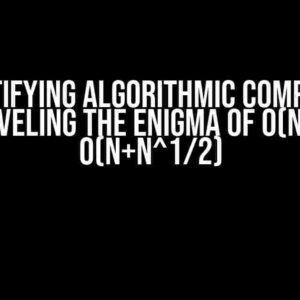Imagine being trapped in a programming conundrum where you need to perform a logical shift right operation, but your processor doesn’t have a dedicated shift instruction. Sounds like a nightmare, right? Fear not, dear programmer, for we’re about to unravel the mystery of logical shift right without dedicated shift instruction!
What is a Logical Shift Right?
A logical shift right is an operation that shifts the bits of a binary number to the right, discarding the least significant bits and filling the vacated positions with zeros. This operation is crucial in various applications, such as data compression, encryption, and bitwise operations.
Why No Dedicated Shift Instruction?
Some processors, especially older or low-power ones, might not have a dedicated shift instruction. This can be due to various reasons, including:
- Instruction set architecture limitations
- Power consumption constraints
- Design trade-offs for performance or area efficiency
However, this doesn’t mean you’re stuck! We can still perform a logical shift right using creative workarounds.
Method 1: Using Arithmetic Right Shift
One way to achieve a logical shift right is by using an arithmetic right shift (SAR) instruction, which is commonly available on most processors. The trick is to use the SAR instruction with a clever twist:
// assume 'x' is the value to be shifted
// and 'n' is the number of positions to shift right
x = (x & ~((1<<n) - 1)) >> n;
This method works because the arithmetic right shift (SAR) instruction preserves the sign bit, but we can exploit this behavior by using a bitmask to clear the least significant bits.
How it Works:
- The expression `(1<<n) – 1` generates a bitmask with ‘n’ trailing ones.
- The bitwise AND operation `x & ~ bitmask` clears the least significant ‘n’ bits of ‘x’.
- The arithmetic right shift `x >> n` shifts the result to the right, filling the vacated positions with zeros (thanks to the SAR instruction).
Method 2: Using Bitwise AND and Right Shift
Another approach is to use a combination of bitwise AND and right shift operations:
// assume 'x' is the value to be shifted
// and 'n' is the number of positions to shift right
x = (x & ~(~0 << n)) >> n;
This method is similar to the previous one, but uses a different sequence of operations:
How it Works:
- The expression `~0` generates a bitmask with all bits set (all ones).
- The left shift `~0 << n` shifts the ones to the left, creating a bitmask with ‘n’ leading zeros.
- The bitwise NOT operation `~` inverts the bitmask, creating a mask with ‘n’ trailing ones.
- The bitwise AND operation `x & bitmask` clears the least significant ‘n’ bits of ‘x’.
- The right shift `x >> n` shifts the result to the right, filling the vacated positions with zeros.
Method 3: Using Lookup Tables
In certain situations, using a lookup table can be an efficient way to perform a logical shift right:
// assume 'x' is the value to be shifted
// and 'n' is the number of positions to shift right
const uint8_t shift_table[256] = {
0x00, 0x00, 0x01, 0x01, 0x02, 0x02, 0x04, 0x04,
0x08, 0x08, 0x10, 0x10, 0x20, 0x20, 0x40, 0x40,
// ... (fill the rest of the table with similar values)
};
x = shift_table[x >> n];
This approach is particularly useful when working with small, fixed-size integers (e.g., 8-bit or 16-bit values). The lookup table contains precomputed values for each possible ‘x’ and ‘n’ combination, allowing for fast and efficient shifting.
Conclusion
Logical shift right without dedicated shift instruction might seem like a daunting task, but with these creative workarounds, you can achieve the desired result. Remember to choose the method that best suits your specific use case, taking into account performance, code size, and complexity.
| Method | Pros | Cons |
|---|---|---|
| Arithmetic Right Shift | Fast, efficient, and widely supported | Requires a SAR instruction |
| Bitwise AND and Right Shift | Flexible, works without SAR instruction | Slower and more complex |
| Lookup Table | Fast, efficient, and easy to implement | Limited to small, fixed-size integers |
Now, go forth and conquer the world of logical shift right without dedicated shift instruction! Remember to always test and optimize your code for your specific use case.
Final Thoughts
In the world of programming, creativity and adaptability are essential skills. By understanding the underlying principles and exploiting the instruction set architecture, you can overcome seemingly insurmountable obstacles. Logical shift right without dedicated shift instruction is just one example of how we can push the boundaries of what’s possible.
So, the next time you encounter a problem that seems impossible, take a step back, think creatively, and remember: where there’s a will, there’s a way!
Frequently Asked Question
Get the inside scoop on logical shift right without dedicated shift instruction!
What is a logical shift right, and why do we need it?
A logical shift right is a bitwise operation that shifts the bits of a binary number to the right, filling the leftmost bits with zeros. We need it because it helps us divide a number by a power of 2, making our code more efficient and optimized. Think of it as a sneaky way to do division without actually using the division operator!
How does logical shift right work without a dedicated shift instruction?
When a dedicated shift instruction is not available, we can use a clever trick to achieve the same result. We can use a combination of bitwise AND and arithmetic right shift operations to mimic the logical shift right behavior. It’s like finding a hidden passage to get to the same destination!
What’s the difference between logical shift right and arithmetic right shift?
Logical shift right fills the leftmost bits with zeros, whereas arithmetic right shift fills them with the sign bit (most significant bit). This means that arithmetic right shift preserves the sign of the number, whereas logical shift right doesn’t. Think of it like the difference between a sunny day and a cloudy day – both are beautiful, but they have different effects!
Can I use logical shift right on signed numbers?
Ah, Ah! Be careful with that! Logical shift right is meant for unsigned numbers. If you try to use it on signed numbers, you might get unexpected results. Imagine trying to put a square peg into a round hole – it just doesn’t fit! Instead, use arithmetic right shift for signed numbers to preserve the sign.
What are some real-world applications of logical shift right?
Logical shift right has many practical uses, such as in image processing, data compression, and cryptography. For instance, it can be used to extract bits from a binary image or to implement efficient algorithms for data encryption. It’s like having a superpower in your coding arsenal!


